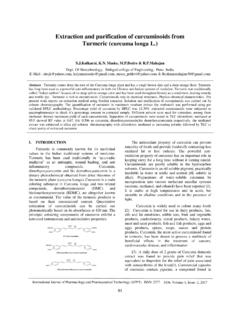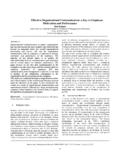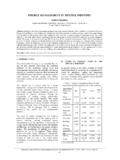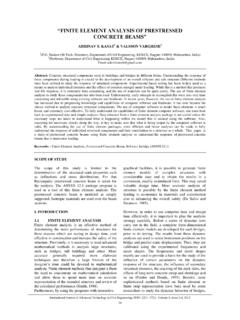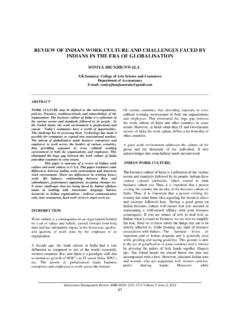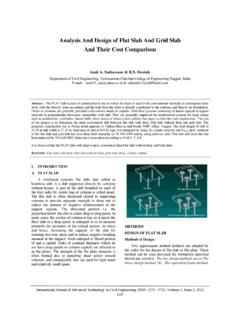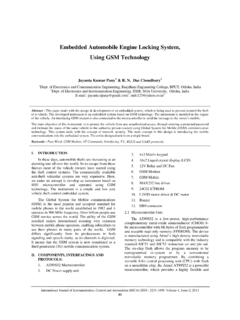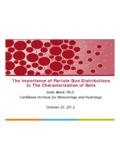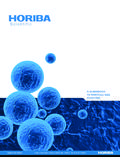Transcription of SHAPE FACTOR ANALYSIS OF ABRASIVE …
1 International Journal of Mechanical and Industrial Engineering (IJMIE) ISSN No. 2231 6477, Vol-2, Iss-4, 2012 35 SHAPE FACTOR ANALYSIS OF ABRASIVE particles used IN SLURRY ABRASION TESTING AVISHKAR RATHOD1, S G SAPATE2 & R. K. KHATIRKAR3 1,2&3 Department of Metallurgical and Materials Engineering, VNIT Nagpur E-mail : Abstract - The engineering components are subjected to surface damage by slurry abrasion such as transportation pipes carrying ore and mineral slurries, extruders, sand pumps and agitators, Apart from stress, ABRASIVE particle hardness, slurry concentration, particle size and SHAPE significantly influences slurry abrasion rate. The effect of ABRASIVE particle SHAPE on slurry abrasion behaviour of steels and cast irons which are widely used for wear protection has not been studied.
2 The particle SHAPE assumes significant importance due to fracture and fragmentation of the particles during the process of abrasion. In the present work, the particle SHAPE characterization of silica sand ABRASIVE particles was carried by SHAPE FACTOR ANALYSIS using image ANALYSIS technique. An attempt was made to correlate the different measures of SHAPE FACTOR with particle size of ABRASIVE particles over a wide range. The characterization of slurry abrasion tester was carried out using slurry abrasion tester with silica sand slurry. The effect of sliding distance on slurry abrasion volume of mild steel was studied. The volume loss increased linearly with sliding distance.
3 The scanning electron microscopic observations of worn our surfaces showed micro-ploughing and cutting as mechanism of material removal. Keywords - slurry, ABRASIVE , SHAPE , SHAPE FACTOR , angularity, image ANALYSIS . I. INTRODUCTION The wear by abrasion accounts for more than 50 % failures of engineering components. In ABRASIVE wear the material is removed from the surface by abrasives which are either fixed to the surface or flow over the surface. Apart from stress, velocity, the properties of ABRASIVE particles significantly influence abrasion rate. With increase in hardness of ABRASIVE particle, the abrasion increases although not proportionately. In fact the relative hardness of ABRASIVE particles decides soft or hard abrasion reflecting in either mild or severe abrasion [1-3].
4 The effect of particle size on ABRASIVE and erosive wear is well established and well documented in the literature [4-9]. However the effect of particle SHAPE has not been studied by many researchers. The particle SHAPE significantly affect abrasion rate, spherical particles causing less wear than angular particles . In practice, the ABRASIVE particles exhibits different shapes due to complex processes involved during crushing and grinding. The SHAPE of the ABRASIVE particle influences the contact load and transition to elastic to plastic contact. The morphology of worn surfaces depends on the SHAPE of ABRASIVE particles . The rounded particles generate crates and smooth grooves while angular particles produced sharp indents and narrow cutting grooves resulting in relatively higher wear rates [9-11].
5 The abrasion rate is also significantly affected by abrasivity of particles , which in turn depends on orientation of ABRASIVE particles with respect to wearing surface. The ABRASIVE particle SHAPE also becomes important due to occurrence of particle fracture and fragmentation during the process of wear. The fractured particles with angular morphology can cause further damage to the surface [11-12]. In this context, the characterization of particle SHAPE becomes important. There are three commonly used SHAPE factors circularity, and Aspect ratio and elongation. One measure of SHAPE is to quantify the closeness to a perfect circle.
6 The circularity is expressed as 4 A/ P2, where A is the particle area and P is its perimeter. Circularity is a ratio of the perimeter of a circle with the same area as the particle divided by the perimeter of the actual particle image. There are alternative definitions of circularity but the definition shown above has a squared term in the numerator and denominator in order to sensitize the parameter to even the most subtle variations in the area-perimeter relationship. Circularity is a good measure of what, in human terms, we could describe as deviation from a perfect circle. The other measure of SHAPE FACTOR is Elongation. A SHAPE symmetrical in all axes such as a circle or square will have an elongation value of zero whereas shapes with large aspect ratios will have an elongation closer to 1.
7 The illustration of circularity and angularity is shown in Fig 1 and 2. A smooth ellipse has a similar elongation as a spiky ellipse of similar aspect ratio. The image ANALYSIS provides two other important benefits; number-based resolution and recording of images. It provides the user with additional information which contributes to a deeper understanding of the product or manufacturing process. The most common measures of particle SHAPE are the SHAPE factors ; the form FACTOR , roundness, elongation and aspect ratio. The SHAPE factors describe the tendency of a particle to deviate from an ideal geometrical prototype often a sphere. This reasoning promotes the impression that SHAPE factors are suitable measures of ABRASIVE potential.
8 It SHAPE FACTOR ANALYSIS of ABRASIVE particles used in Slurry Abrasion Testing International Journal of Mechanical and Industrial Engineering (IJMIE) ISSN No. 2231 6477, Vol-2, Iss-4, 2012 36 has been demonstrated that there is no simple relationship between the magnitude of SHAPE factors and wear rate. There have been limited studies carried out to characterize ABRASIVE particle SHAPE [13-17] and fracture and fragmentation of ABRASIVE particles with respect to slurry abrasion of steels and cast irons, which are widely used for wear protection of engineering components. [18-22]. : Illustration of circularity Fig. 2 : Illustration of angularity and elongation In the present study the SHAPE FACTOR ANALYSIS of silica sand particles as a function of their size is presented.
9 The silica sand has harder than those ABRASIVE particles encountered in conveyor belts, transportation of ore and mineral slurries through pipelines, sand pumps, extruders and agitators where surface damage by slurry abrasion is a potential problem. The ABRASIVE particles were crushed, ground and subjected to sieve ANALYSIS . The representative samples were observed under scanning electron microscope to study size distribution and SHAPE . The SHAPE FACTOR ANALYSIS was carried out using Image ANALYSIS . An attempt is made to correlate different measures of SHAPE FACTOR with particle size. The slurry abrasion tester to be used for slurry abrasion testing using ABRASIVE these slurries was also characterized.
10 II. EXPERIMENTAL The silica sand particles were selected in the present investigation as the slurry medium. The silica sand particles were sieve analyzed to obtain different fractions and representative samples were coated with gold for observing particle size distribution and SHAPE . Six different particle size distributions were used for particle SHAPE FACTOR ANALYSIS which were 600-850 m, 450-600 m, 300-450 m, 212-300 m, 150-212 m and 106-150 m. Fig 3 shows SEM photographs of some of the silica sand particles used in this investigation. The SHAPE FACTOR measurements were carried out by the technique reported earlier. For SHAPE FACTOR ANALYSIS the particles were spread on glued to the glass slide and observed under optical microscope.
